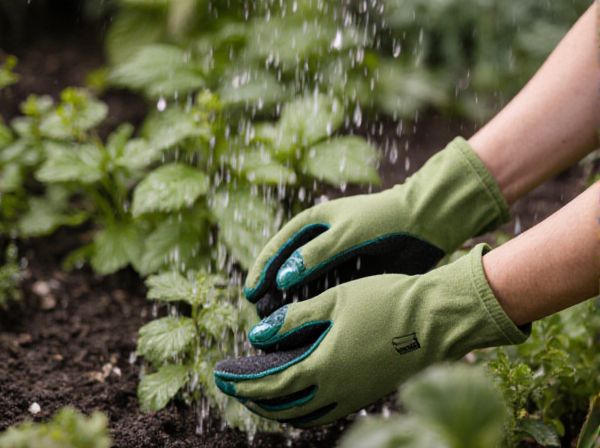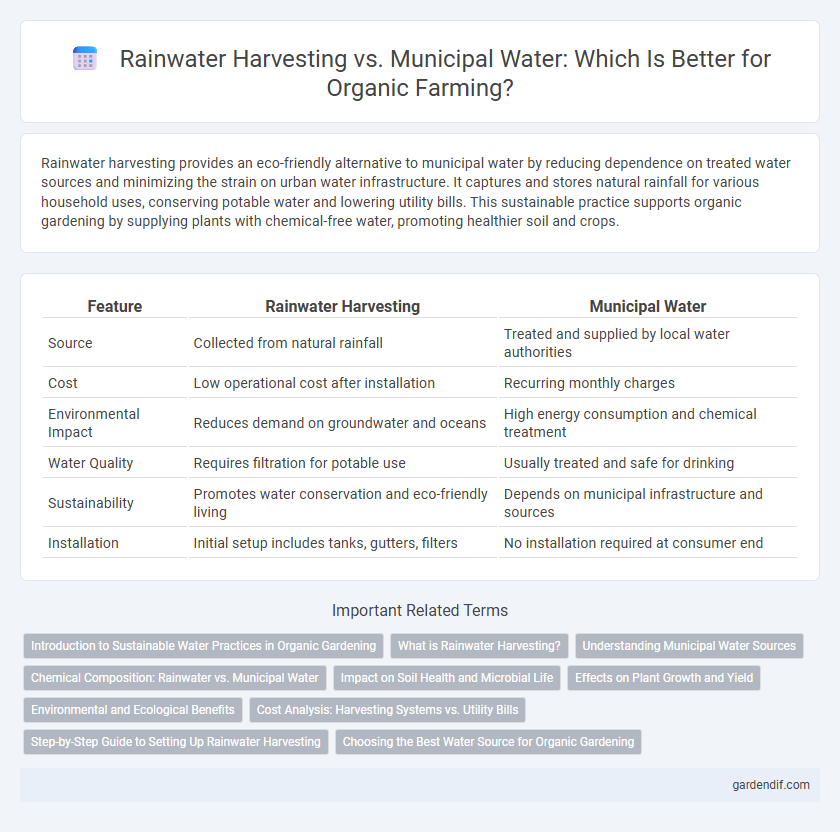
Rainwater harvesting vs municipal water Illustration
Rainwater harvesting provides an eco-friendly alternative to municipal water by reducing dependence on treated water sources and minimizing the strain on urban water infrastructure. It captures and stores natural rainfall for various household uses, conserving potable water and lowering utility bills. This sustainable practice supports organic gardening by supplying plants with chemical-free water, promoting healthier soil and crops.
Table of Comparison
| Feature | Rainwater Harvesting | Municipal Water |
|---|---|---|
| Source | Collected from natural rainfall | Treated and supplied by local water authorities |
| Cost | Low operational cost after installation | Recurring monthly charges |
| Environmental Impact | Reduces demand on groundwater and oceans | High energy consumption and chemical treatment |
| Water Quality | Requires filtration for potable use | Usually treated and safe for drinking |
| Sustainability | Promotes water conservation and eco-friendly living | Depends on municipal infrastructure and sources |
| Installation | Initial setup includes tanks, gutters, filters | No installation required at consumer end |
Introduction to Sustainable Water Practices in Organic Gardening
Rainwater harvesting offers an eco-friendly alternative to municipal water by capturing and utilizing natural rainfall for organic gardening, reducing dependency on treated water sources. This practice conserves water, lowers utility costs, and minimizes the environmental impact of water extraction and distribution. Integrating rainwater harvesting aligns with sustainable water management principles, promoting healthier soil and plant growth in organic systems.
What is Rainwater Harvesting?
Rainwater harvesting is the process of collecting and storing rainwater from rooftops, land surfaces, or rock catchments to utilize as an alternative water source. This sustainable method reduces dependence on municipal water systems, conserving treated water and lowering water bills. Rainwater harvesting systems typically include gutters, storage tanks, and filtration units to ensure safe and efficient water collection.
Understanding Municipal Water Sources
Municipal water primarily originates from surface water sources such as rivers, lakes, and reservoirs, as well as groundwater aquifers accessed through wells. These sources undergo treatment processes to meet safety standards before distribution to households and businesses. Understanding the origin and treatment of municipal water highlights the contrasting benefits of rainwater harvesting, which captures and utilizes natural precipitation without extensive processing.
Chemical Composition: Rainwater vs. Municipal Water
Rainwater typically contains fewer chemical contaminants compared to municipal water, as it is free from chlorine, fluoride, and other treatment chemicals commonly added to public water supplies. Municipal water often includes disinfectants, such as chlorine or chloramine, and may have trace amounts of heavy metals from pipe corrosion, impacting its chemical composition. The purity of rainwater depends on environmental factors like air pollution, whereas municipal water quality is regulated and monitored to meet safety standards.
Impact on Soil Health and Microbial Life
Rainwater harvesting significantly enhances soil health by providing nutrient-rich, chemical-free water that promotes microbial diversity and activity, essential for nutrient cycling and soil structure. In contrast, municipal water often contains chlorine and other chemicals that can disrupt soil microbial communities, reducing soil fertility and biological functions. Utilizing harvested rainwater supports sustainable agriculture and organic gardening by maintaining a balanced soil ecosystem and improving long-term soil resilience.
Effects on Plant Growth and Yield
Rainwater harvesting provides plants with natural, nutrient-rich water free of chemicals and salts commonly found in municipal water, promoting healthier root development and increased crop yield. Studies show that rainwater enhances soil moisture retention and microbial activity, leading to better nutrient absorption and improved plant growth compared to treated municipal water. Utilizing harvested rainwater reduces dependence on chlorinated municipal supplies, resulting in higher quality produce and sustainable agricultural practices.
Environmental and Ecological Benefits
Rainwater harvesting reduces reliance on municipal water supplies, conserving energy and lowering greenhouse gas emissions associated with water treatment and distribution. This practice promotes groundwater recharge, prevents soil erosion, and mitigates urban flooding, enhancing local ecosystems' resilience. Utilizing harvested rainwater minimizes chemical pollutants entering natural waterways, supporting biodiversity and sustaining ecological balance.
Cost Analysis: Harvesting Systems vs. Utility Bills
Rainwater harvesting systems require a one-time investment for collection, filtration, and storage infrastructure, resulting in significantly lower long-term expenses compared to recurring municipal water bills. Over time, savings from reduced utility costs can offset initial setup expenses within 3-7 years depending on system capacity and regional water rates. Maintenance costs for rainwater systems are minimal, making them a cost-effective and sustainable alternative to fluctuating and often increasing municipal water charges.
Step-by-Step Guide to Setting Up Rainwater Harvesting
Installing a rainwater harvesting system involves selecting appropriate catchment surfaces, typically rooftops, and installing gutters and downspouts to direct water into storage tanks made of durable, food-grade materials. Next, incorporate first-flush diverters and filtration systems to remove debris and contaminants, ensuring the collected water is clean for irrigation or household use. Finally, integrate a pump and distribution system tailored to your garden or home's needs, optimizing water efficiency while reducing reliance on municipal water supplies and lowering utility costs.
Choosing the Best Water Source for Organic Gardening
Rainwater harvesting offers organic gardeners a sustainable, chemical-free water source rich in natural minerals, promoting healthier plant growth compared to municipal water often treated with chlorine and fluoride. Utilizing rainwater reduces dependency on municipal supplies, lowering environmental impact and enhancing soil vitality through natural hydration cycles. Selecting rainwater supports eco-friendly gardening practices, ensuring organic crops remain free from synthetic contaminants commonly found in treated municipal water.
Rainwater harvesting vs municipal water Infographic

 gardendif.com
gardendif.com